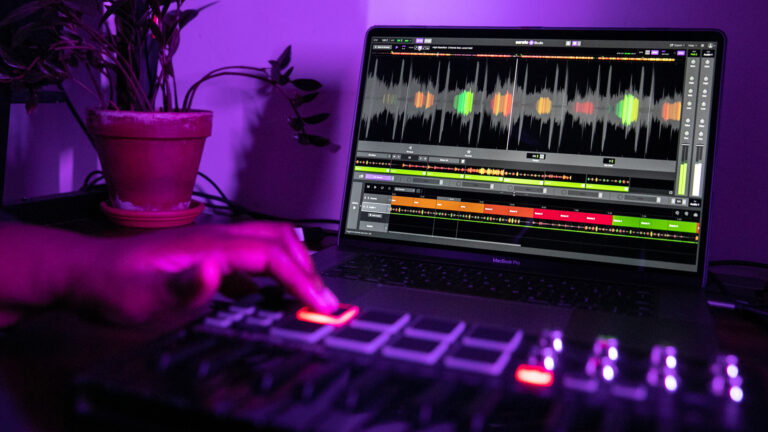“In the software, stem separation really sounds great. It’s certainly on par with the stem-separation algorithm found in Serato DJ Pro.”
Arguably, the overlap between the worlds of DJing and music production has never been greater, or better. DJ software continues to push the boundaries for what is possible – effects are basically studio-plug-in-grade and the advent of real-time stem separation has opened up entirely new creative possibilities.
Maybe nothing better illustrates the overlap between music production and DJing than DJ-software companies rolling out their own production software. To wit, we saw Serato Studio 2.0 introduced earlier this year, and it’s a major update to the beat-making platform that was first released in 2019.
By now, New Zealand-based Serato should be a name familiar to most DJs. Serato DJ Pro is one of the very most popular DJ-software options currently on the market and has a devoted following. However, the name Serato may not generate the same recognition among music producers.
That could certainly change with the latest generation of Serato Studio, which hopes to woo both DJs and producers alike with a rich feature set and sample-focused workflow. Interestingly, the Serato story actually started in 1999 with the release of the time-stretching/pitch-shifting plug-in “Pitch ‘n Time.” Will Serato Studio 2.0 more fully ingrain the company in the world of music production?
Before I dive into Serato Studio 2.0, I want to get something off my chest. I am probably the world’s most mediocre producer. I’ll probably never be able to surprise my friends and family with an overnight dance hit that tops global charts and propels me to the main stages of your favorite music festival. So, maybe I am underqualified to review music-production software. Or, perhaps my insecurity with production makes me the perfect person to review Serato Studio. After all, if I can get the hang of it – and I think I did – maybe anyone can.
The centerpiece of Serato Studio 2.0 is real-time stems separation – in other words, the ability to split a song into distinct pseudo-tracks with each containing either vocals, drums, and melodies. With this feature, you can create acappellas or instrumental edits on-the-fly and alter one without affecting the others. This technology has been emerging in various DJ software and hardware platforms in recent years and has unlocked new creative possibilities for DJs. It’s certainly not a fad or a gimmick and is likely here to stay.
In the software, stem separation really sounds great. It’s certainly on par with the stem-separation algorithm found in Serato DJ Pro. Of course, an acappella created through stem separation is not going to sound as clean as a true studio acappella, but it can get pretty close under the right circumstances. With the introduction of stems in Serato Studio 2.0, Serato appears to be going after remixers and producers wanting to take their sampling game to the next level. In fact, they call it “the single biggest breakthrough in sampling technology since the digital sampler.” It’s a bold claim, and I think we’ll have to let history be the judge on that one. But Serato is definitely onto something here.
The rest of the Serato Studio 2.0 workflow is very similar to Version 1.0, which debuted a few years ago. There is the ability to load various drum kits and build a beat using a drum machine-style workflow. When compared with other music-production platforms, a real defining feature of Serato Studio is the ability to load tracks directly from your Serato DJ library. There’s also the ability to layer on some synths and throw effects on the track you’ve created.
Various phrases of a project are split into sections known as “scenes,” and you can chain multiple scenes together to form a track. The software seems to focus more around sampling various sources, as opposed to building entirely new songs from scratch. As a platform to create remixes and edits of preexisting tracks, Serato Studio offers a nice blend of DJ and production software.
In the software, there are nods to DJs everywhere. For instance, there is a central mixer-style section in the middle of the interface – it even has the 3-band EQ that we’re all used to. Having said that, music-production super-users might find more-featured music production platforms to be a better fit – especially if they’re trying to create distribution-ready tracks for a record label.
So, who might be the perfect user for Serato Studio 2.0? I think hip-hop DJs and producers will really appreciate the sampling-focused workflow and the stems separation. They might be able to quickly create specific edits and then bring those edits to a live setting with ease. DJs of any genre might also be able to make mash-ups of songs or even seamless transitions between songs in the software.
As a beat-making tool, Serato Studio 2.0 might also appeal to non-DJs who want to be able to quickly put together a beat. DJs who are wanting to get their feet wet with music production might also consider giving Serato Studio 2.0 a try.
There are two flavors of Serato Studio: a free version and a paid version. Importantly, both the free version and the paid version contain real-time stem separation, which I’m very glad to see. The free version is limited in the number of audio tracks, sound packs, drum kits, and instruments users have access to. My recommendation would be to try the free version and see if the software makes sense with your workflow. If it does, the $9.99-a-month subscription or a one-time $249 price for the paid version might be very compelling.
Thumbs up on Serato Studio 2.0.


